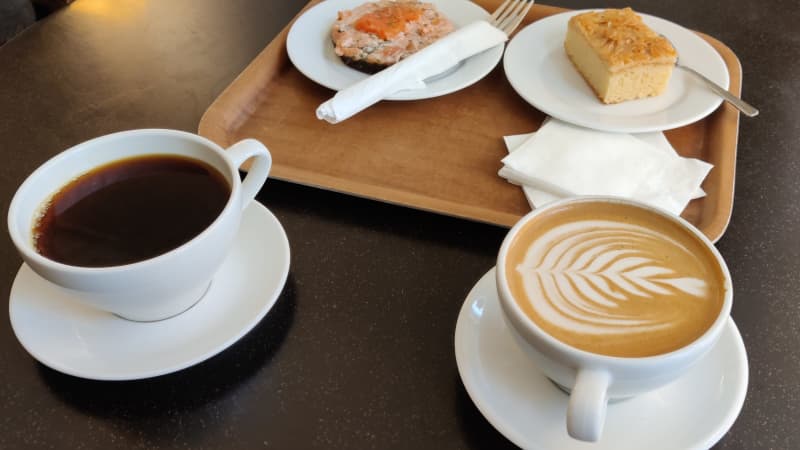Those following a gluten-free diet must plan their holiday trip carefully. Konkari encourage you to check the gluten-freeness of the dish many times. We put together six tips for smooth travel.
Laaksonen has already learned that at the coffee counter you have to remember to ask if gluten-free oat milk is available. If you only ask for oat milk, there may be a product added to the coffee that causes the celiac’s intestines to react.
In Laaksose, it has often happened that the first oat milk that is not suitable for celiacs is offered. Sometimes there is no oat milk in the cafe at all, and then he usually gives up coffee.

Oats may contain gluten from other grains
Many people know that oats are usually good for celiacs. So why might oat milk be a problem?
Regular oat milk is made from oats that have traveled the normal distance from the field to the jar. During the process, it has been processed in a bakery where other grains have also been processed. At this point, gluten has probably contaminated the product from the point of view of celiac disease.
Gluten-free oat milk travels separately from other types of cereal during the entire processing journey, so contamination does not occur.
Two varieties of oat milk are made mainly because the largest consumer group of oat milk is vegans and other people who prefer vegetarian food. It is enough for them that no animal-derived raw materials have been used in its production.
On the side of the oat milk jar, it says whether it is regular oat milk or gluten-free oat milk.
The gluten labels vary during the trip
– The tour of Israel and Jordan had a very good guide, and everything worked out. In India, the guide was of the opinion that you can see for yourself what you can eat, Hyvönen recalls.
– I thought I had to eat borscht soup all week because it is gluten-free. Somewhere, however, it was frosted with puff pastry, Leskinen regrets.
In Leskinen’s opinion, the trip is most likely to be successful if you clear things up well before the trip. According to Hyvönen, you have to make sure the food is really gluten-free many times.
In all restaurants, special diets are not taken as seriously as in Finland. Now the place of danger can come in the fact that during the corona, many restaurant professionals have left their jobs and have been replaced by new inexperienced people. Or maybe the cup selection is still lacking after the corona.
The Celiac Association encourages you to visit online
Celiacs should therefore prepare their trip carefully in order to avoid the biggest stumbling blocks. According to the Celiac Association, you can find a lot of tips on the internet about gluten-free food in different countries and often also in restaurants.
The gluten-free service label is already in use in several European countries. The sign tells you that the cafe or restaurant offers reliably gluten-free dishes.
Information about cafes and restaurants that have received the right to use the mark can be found on the website of AOECS (www.aoecs.org), the umbrella organization of the European Celiac Associations.
In addition, the Celiac Association encourages reading travel experiences and picking up practical tips online. Here we put together six important tips.
1. State your special diet
If you’re booking a group trip, let the travel agency know about your special diet and they’ll pass the information on to the airlines. If you book the flights yourself, inform the airline of your special dietary needs. According to the experiences of the Celiac Association, there are variations in the gluten-free offer of airlines.
If you want to prepare gluten-free food yourself, you should choose an apartment hotel with cooking facilities. It is recommended to inform the hotel about a special diet in advance.
2. Remember the language translation
It is important to print a language translation with you on the trip, i.e. an explanation about celiac disease and the gluten-free diet. Also check that it has been translated into the language of the destination country. A translation is a great help when dining in a restaurant.
3. Book snacks to take with you
Just in case, you should book gluten-free snacks for the trip, especially if you are unsure about getting gluten-free food in the destination country.
You can pack, for example, crackers, bread packed in shielding gas, cookies and bars in the bag. If you prepare food yourself, bring porridge ingredients, gluten-free pasta and flour mixes.
Also take into account the import restrictions of different countries. Food may not be exported to all countries.
4. A toast bag is the salvation of a hotel breakfast
A roasting bag is unknown to many Finns, but celiacs do know it and it’s a great idea when traveling.
The celiac association sells toasting bags, and they are used to toast bread. By slipping a slice of gluten-free bread into a toasting bag, you can toast it in the toaster of the hotel in the destination country safely and without stomach upsets.
5. Check the packaging labels in the store
In many travel destinations, gluten-free products can be found in department stores and supermarkets. In some countries, gluten-free products can be sold in pharmacies and health food stores.
The brand of the gluten-free product is used in almost 30 European countries and more than 22,000 products have received it.
6. Prefer clear portions in restaurants, not questionable sauces
In restaurants, you should order clear portions that are unbreaded and sauce-free. Tell us about your gluten-free diet every time you order a dish, and make sure the dish is gluten-free when it comes to the table. Also show language translation if needed.
Depending on the country and the restaurant, gluten-free can be marked in different ways, so be careful. In one restaurant, the G marking may mean that the dish is gluten-free, and in another, that it contains gluten.

